Compact Reflective Metasurface: Production of Broadband Vortex Beams in Millimeter Waves
Abstract
1. Introduction
2. Element Design and Analysis
3. Advanced Reflectarray Design and Evaluation Techniques
4. Simulated and Measured Results
5. Conclusions
Author Contributions
Funding
Institutional Review Board Statement
Informed Consent Statement
Data Availability Statement
Acknowledgments
Conflicts of Interest
References
- Essiambre, R.-J.; Kramer, G.; Winzer, P.J.; Foschini, G.J.; Goebel, B. Capacity limits of optical fiber networks. J. Light. Technol. 2010, 28, 662–701. [Google Scholar] [CrossRef]
- Kawaguchi, H.; Kubo, S.; Nakamura, H. Orbital angular momentum of vortex fields in corrugated cylindrical waveguide hybrid mode. IEEE Microw. Wirel. Technol. Lett. 2022, 33, 118–121. [Google Scholar] [CrossRef]
- Huang, K.; Liu, H.; Restuccia, S.; Mehmood, M.Q.; Mei, S.-T.; Giovannini, D.; Danner, A.; Padgett, M.J.; Teng, J.-H.; Qiu, C.-W. Spiniform phase-encoded metagratings entangling arbitrary rational-order orbital angular momentum. Light. Sci. Appl. 2018, 7, 17156. [Google Scholar] [CrossRef]
- Hui, X.; Zheng, S.; Hu, Y.; Xu, C.; Jin, X.; Chi, H.; Zhang, X. Ultralow reflectivity spiral phase plate for generation of millimeter-wave OAM beam. IEEE Antennas Wirel. Propag. Lett. 2015, 14, 966–969. [Google Scholar] [CrossRef]
- Liu, K.; Cheng, Y.; Li, X.; Jiang, Y. Passive OAM-based radar imaging with single-in-multiple-out mode. IEEE Microw. Wirel. Compon. Lett. 2018, 28, 840–842. [Google Scholar] [CrossRef]
- Zheng, P.; Zhu, Z.; Pei, X.; Wu, Q.; Liang, H.; Chen, Y.; Li, J.; Xie, X. Compound super-oscillation lens for reflective confocal imaging. Opt. Lasers Eng. 2023, 166, 107572. [Google Scholar] [CrossRef]
- Wang, Y.; Yuan, Y.; Yang, G.; Ding, X.; Wu, Q.; Jiang, Y.; Burokur, S.N.; Zhang, K. Perfect control of diffraction patterns with phase-gradient metasurfaces. ACS Appl. Mater. Interfaces 2022, 14, 16856–16865. [Google Scholar] [CrossRef]
- Yu, S.; Li, L.; Shi, G.; Zhu, C.; Shi, Y. Generating multiple orbital angular momentum vortex beams using a metasurface in radio frequency domain. Appl. Phys. Lett. 2016, 108, 242401. [Google Scholar] [CrossRef]
- Yuan, Y.; Sun, S.; Chen, Y.; Zhang, K.; Ding, X.; Ratni, B.; Wu, Q.; Burokur, S.N.; Qiu, C.-W. A fully phase-modulated metasurface as an energy-controllable circular polarization router. Adv. Sci. 2020, 7, 2001437. [Google Scholar] [CrossRef]
- Akram, Z.; Li, X.; Qi, Z.; Aziz, A.; Yu, L.; Zhu, H.; Jiang, X.; Li, X. Wideband vortex beam reflectarray design using quarter-wavelength element. IEEE Antennas Wirel. Propag. Lett. 2019, 18, 1458–1462. [Google Scholar] [CrossRef]
- Zhang, K.; Wang, Y.; Burokur, S.N.; Wu, Q. Generating dual-polarized vortex beam by detour phase: From phase gradient metasurfaces to metagratings. IEEE Trans. Microw. Theory Tech. 2021, 70, 200–209. [Google Scholar] [CrossRef]
- Wang, Z.; Zhou, D.; Liu, Q.; Yan, M.; Wang, X. Dual-mode vortex beam transmission metasurface antenna based on linear-to-circular polarization converter. Opt. Express 2023, 31, 35632–35643. [Google Scholar] [CrossRef]
- Khan, A.; Zhang, J.; Ishfaq, M.; Bilal, H.M.; Khan, S.; Soothar, K.K. Design and analysis of a 1-bit reflective metasurface for reconfigurable intelligent surface applications in the Ka-band. In Proceedings of the 2024 Asia Communications and Photonics Conference (ACP) and International Conference on Information Photonics and Optical Communications (IPOC), Beijing, China, 2–5 November 2024; IEEE: Piscataway, NJ, USA, 2024; pp. 1–5. [Google Scholar]
- He, B.; Liu, J.; Cheng, Y.; Chen, F.; Luo, H.; Li, X. Broadband and thermally switchable reflective metasurface based on Z-shape InSb for terahertz vortex beam generation. Phys. E 2022, 144, 115373. [Google Scholar] [CrossRef]
- Chen, G.-T.; Jiao, Y.-C.; Zhao, G. A reflectarray for generating wideband circularly polarized orbital angular momentum vortex wave. IEEE Antennas Wirel. Propag. Lett. 2018, 18, 182–186. [Google Scholar] [CrossRef]
- Rao, J.; Wang, C.; Yu, H.; Xu, G.; Ren, X.; Zhao, L.; Li, Y.; Huang, Z. Conical conformal OAM-generating transmitarray with high transmission double C-shaped grating metasurface. Opt. Express 2024, 32, 34128–34140. [Google Scholar] [CrossRef] [PubMed]
- Guo, C.; Zhao, X.; Zhu, C.; Xu, P.; Zhang, Y. An OAM patch antenna design and its array for higher-order OAM mode generation. IEEE Antennas Wirel. Propag. Lett. 2019, 18, 816–820. [Google Scholar] [CrossRef]
- Rao, M.V.; Malik, J.; Yuvaraj, S.; Kartikeyan, M.V. Polarization-insensitive reflectarray for OAM beam generation over octave bandwidth for 5G applications. AEÜ-Int. J. Electron. Commun. 2023, 170, 154775. [Google Scholar] [CrossRef]
- Meng, X.; Wu, J.; Wu, Z.; Qu, T.; Yang, L. Dual-polarized reflectarray for generating dual beams with two different orbital angular momentum modes based on independent feeds in C- and X-bands. Opt. Express 2018, 26, 23185–23195. [Google Scholar] [CrossRef]
- Huang, H.-F.; Li, S.-N. High-efficiency planar reflectarray with small-size for OAM generation at microwave range. IEEE Antennas Wirel. Propag. Lett. 2019, 18, 432–436. [Google Scholar] [CrossRef]
- Yang, P.; Yang, R.; Li, Y. Compact cascaded metasurface system for controlling the spin and orbital angular momentum of electromagnetic fields simultaneously. Opt. Express 2021, 29, 20229–20239. [Google Scholar] [CrossRef]
- Han, D.-H.; Wei, X.-C.; Zhao, X.-W. Wideband OAM generator design using a low Q-factor and C-shaped element. IEEE Microw. Wirel. Technol. Lett. 2023, 33, 615–618. [Google Scholar] [CrossRef]
- Nayeri, P.; Yang, F.; Elsherbeni, A.Z. Reflectarray Antennas: Theory, Designs, and Applications; John Wiley & Sons: Hoboken, NJ, USA, 2018. [Google Scholar]
- Aieta, F.; Genevet, P.; Kats, M.A.; Yu, N.; Blanchard, R.; Gaburro, Z.; Capasso, F. Aberration-free ultrathin flat lenses and axicons at telecom wavelengths based on plasmonic metasurfaces. Nano Lett. 2012, 12, 4932–4936. [Google Scholar] [CrossRef] [PubMed]
- Yao, E.; Franke-Arnold, S.; Courtial, J.; Barnett, S.; Padgett, M. Fourier relationship between angular position and optical orbital angular momentum. Opt. Express 2006, 14, 9071–9076. [Google Scholar] [CrossRef] [PubMed]
- Noamadeh, Z.; Giden, I.H.; Aksoy, E. Polarization-insensitive, wideband reflective metasurface generating orbital angular momentum vortex beam. Optik 2024, 311, 171921. [Google Scholar] [CrossRef]
- Li, B.; Jing, P.F.; Sun, L.Q.; Leung, K.W.; Lv, X. 3D printed OAM reflectarray using half-wavelength rectangular dielectric element. IEEE Access 2020, 8, 142892–142899. [Google Scholar] [CrossRef]

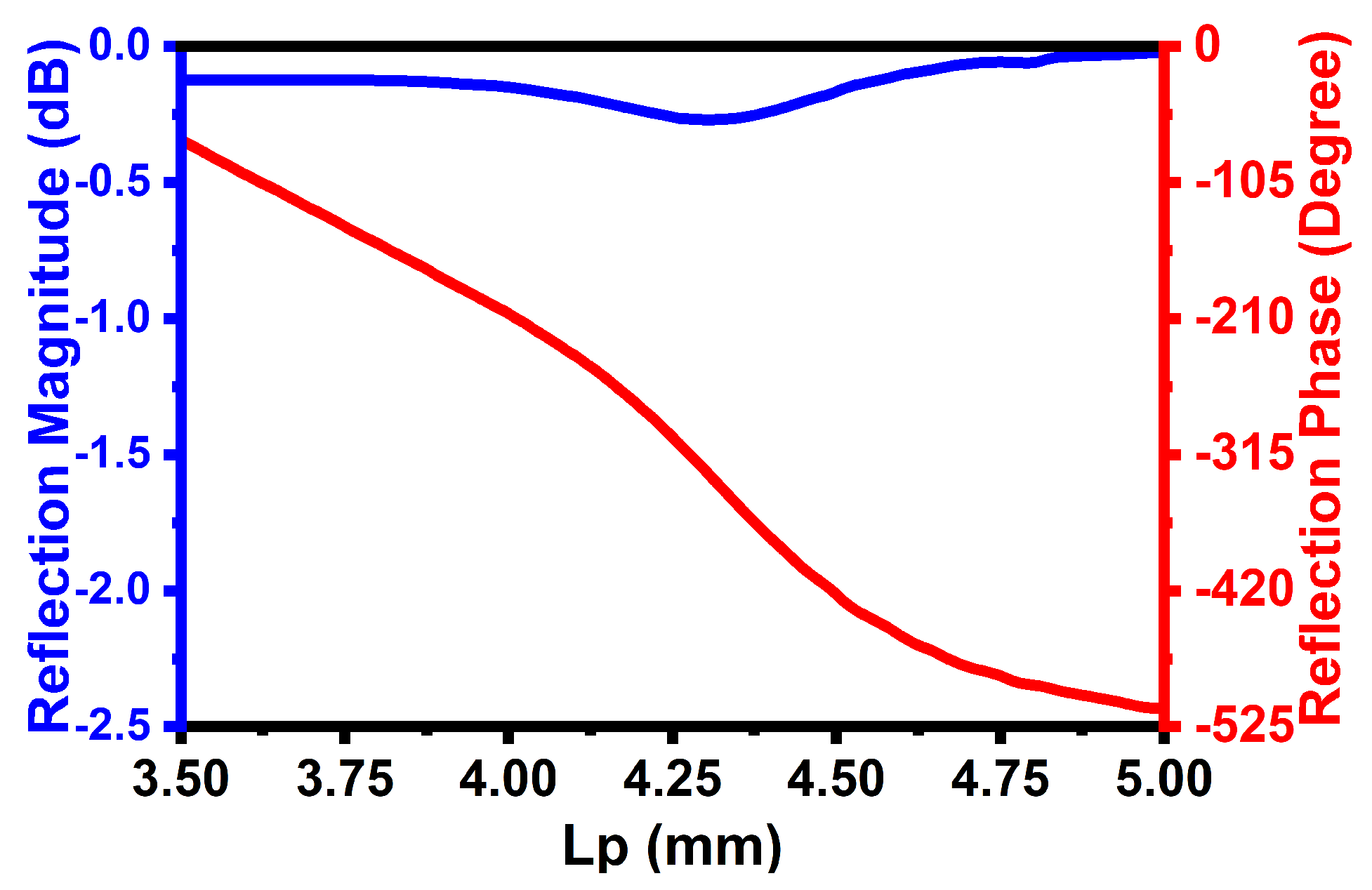
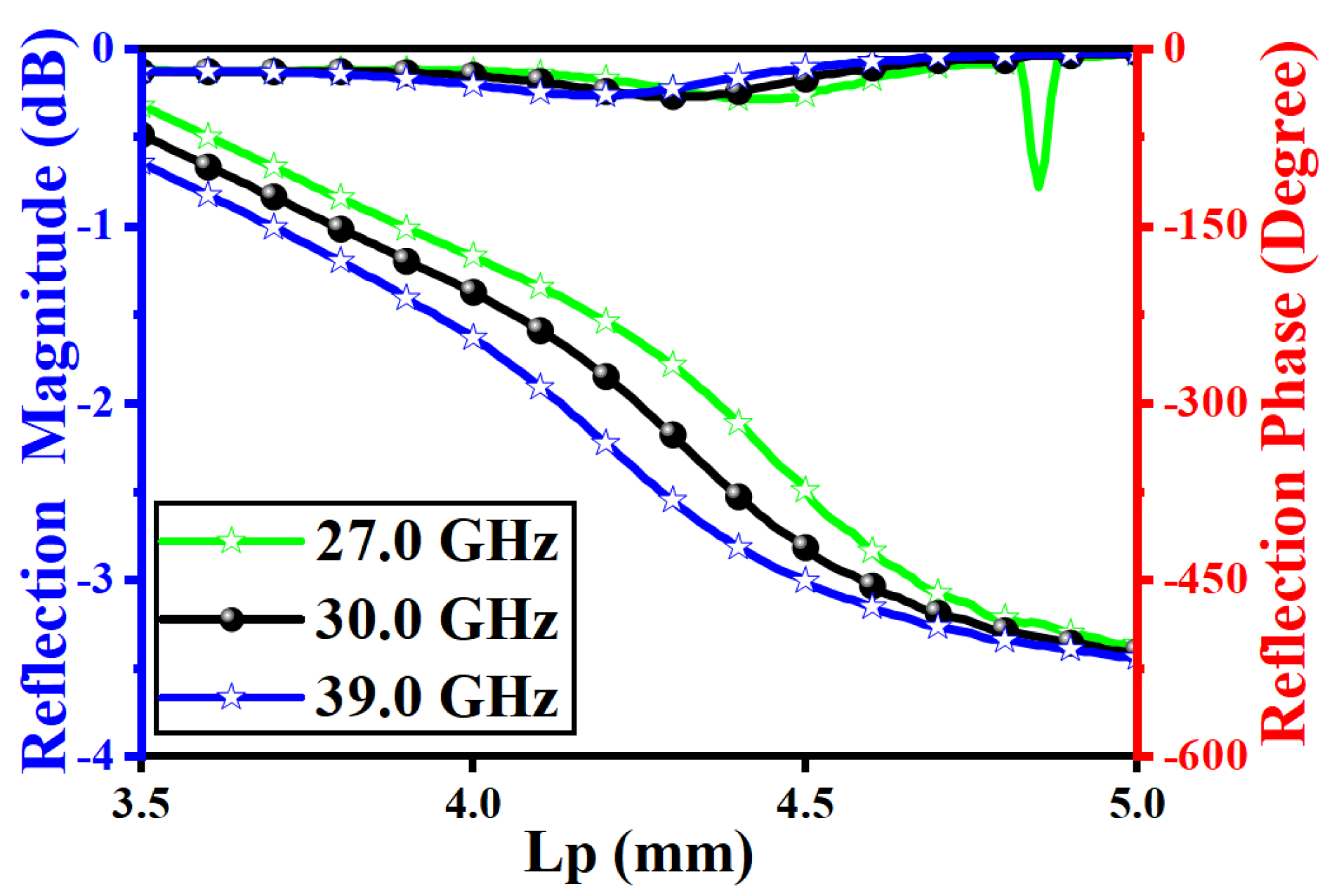

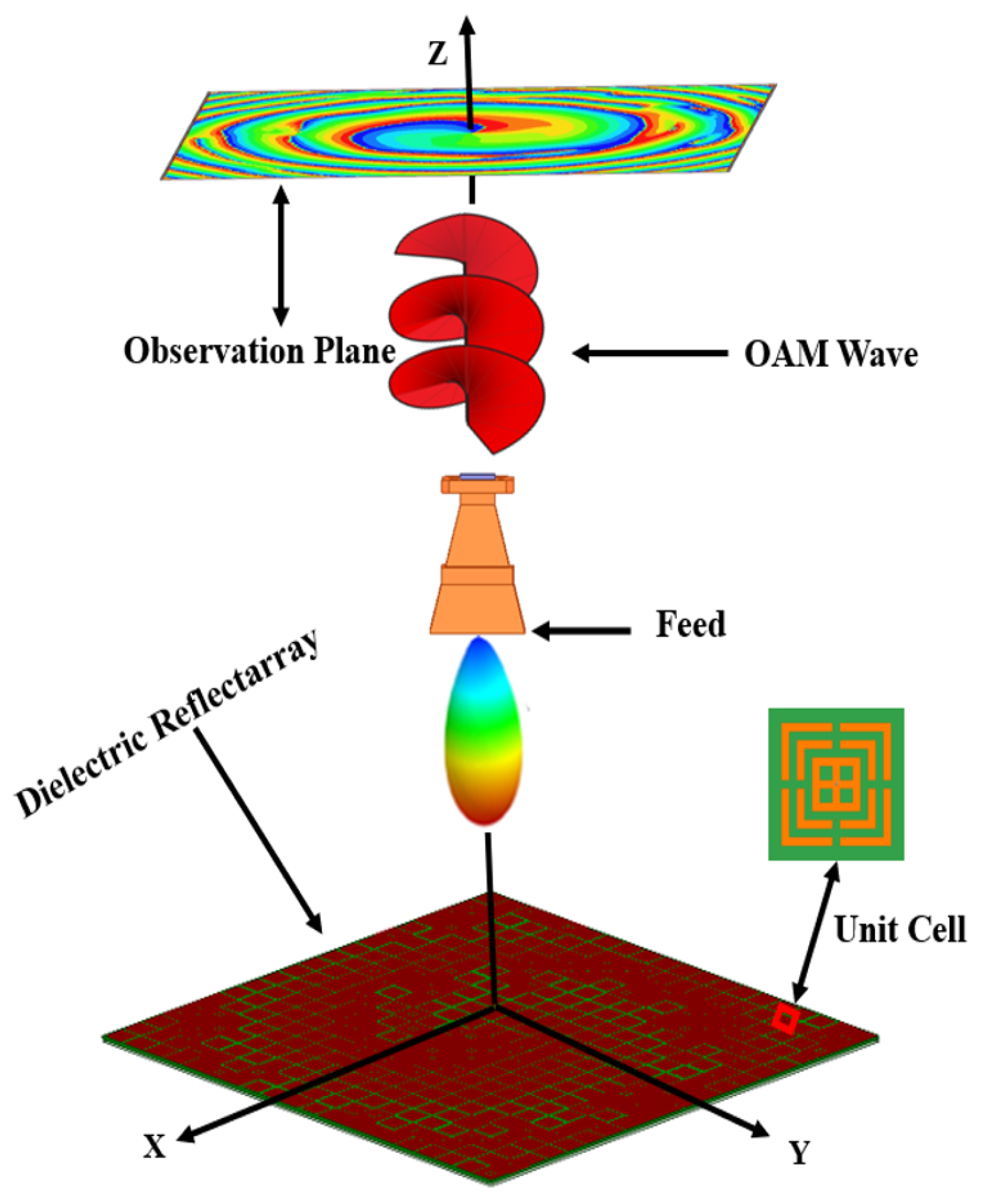
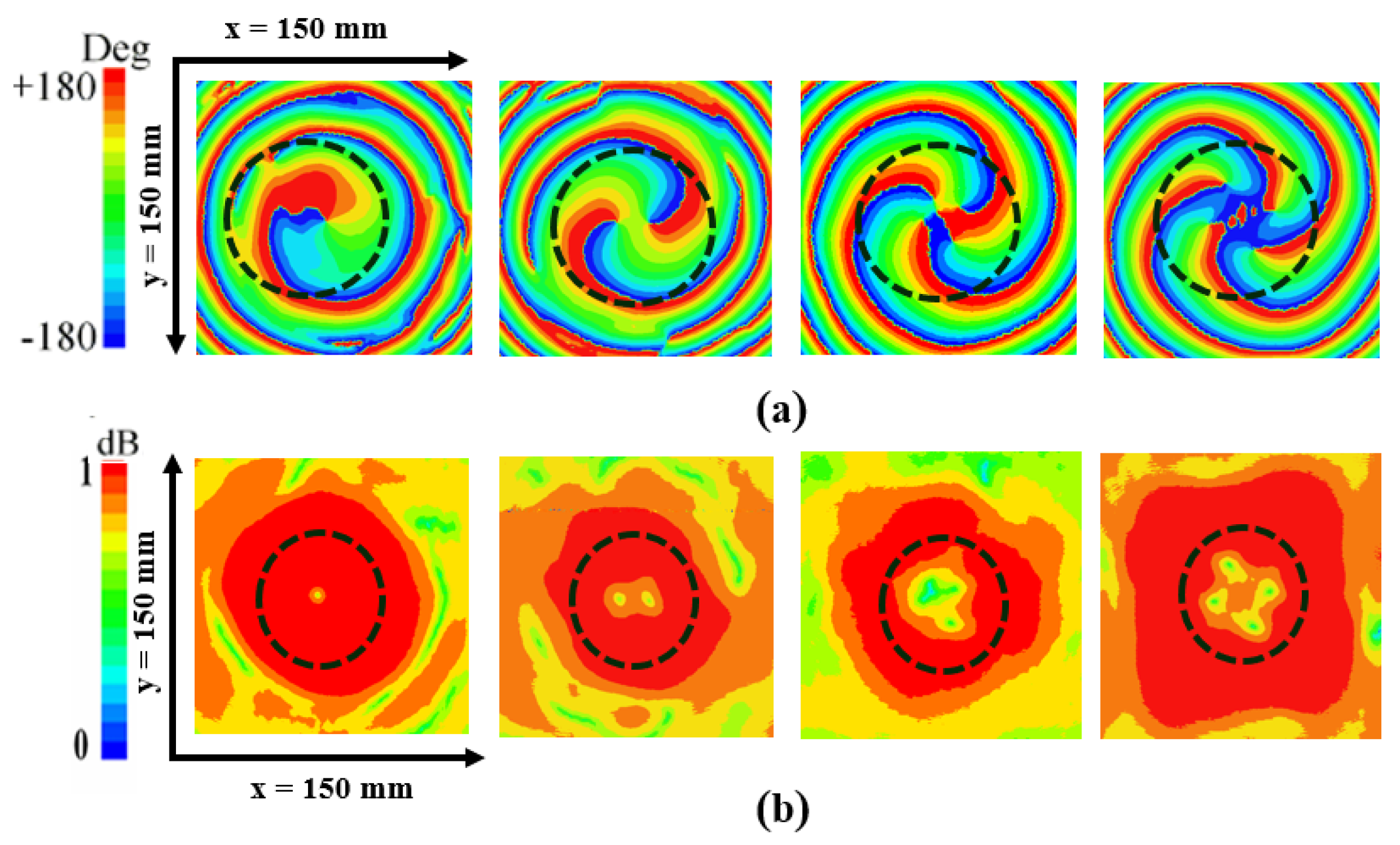

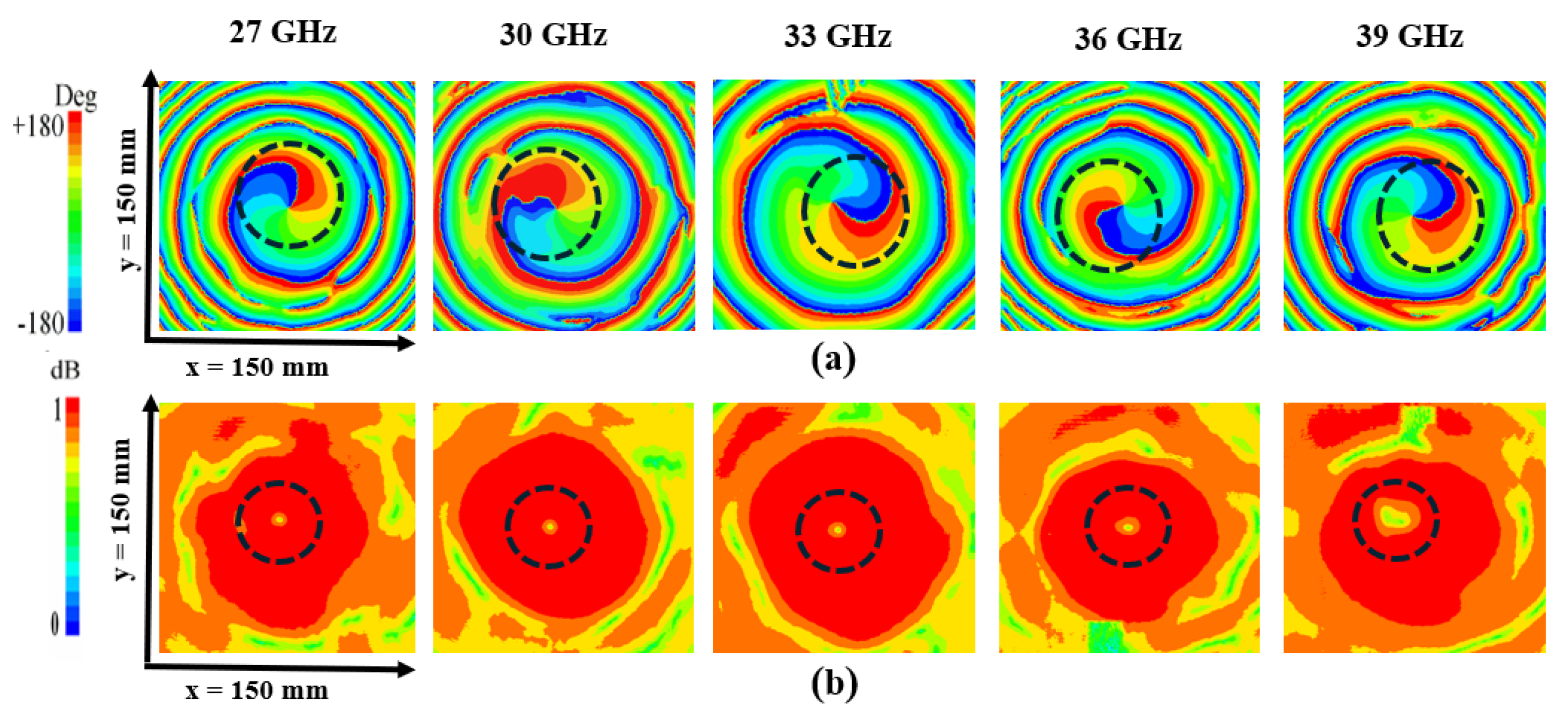

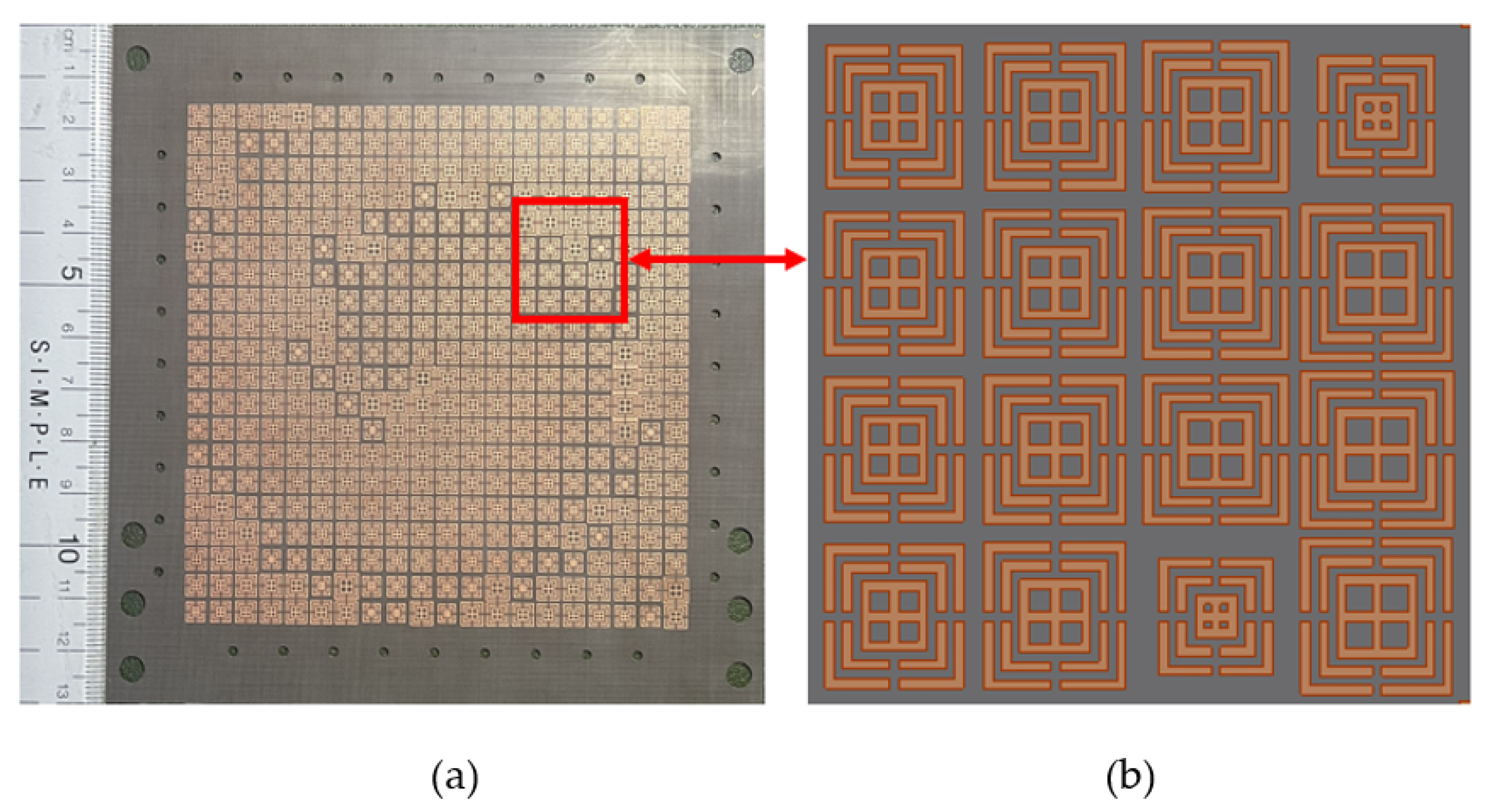
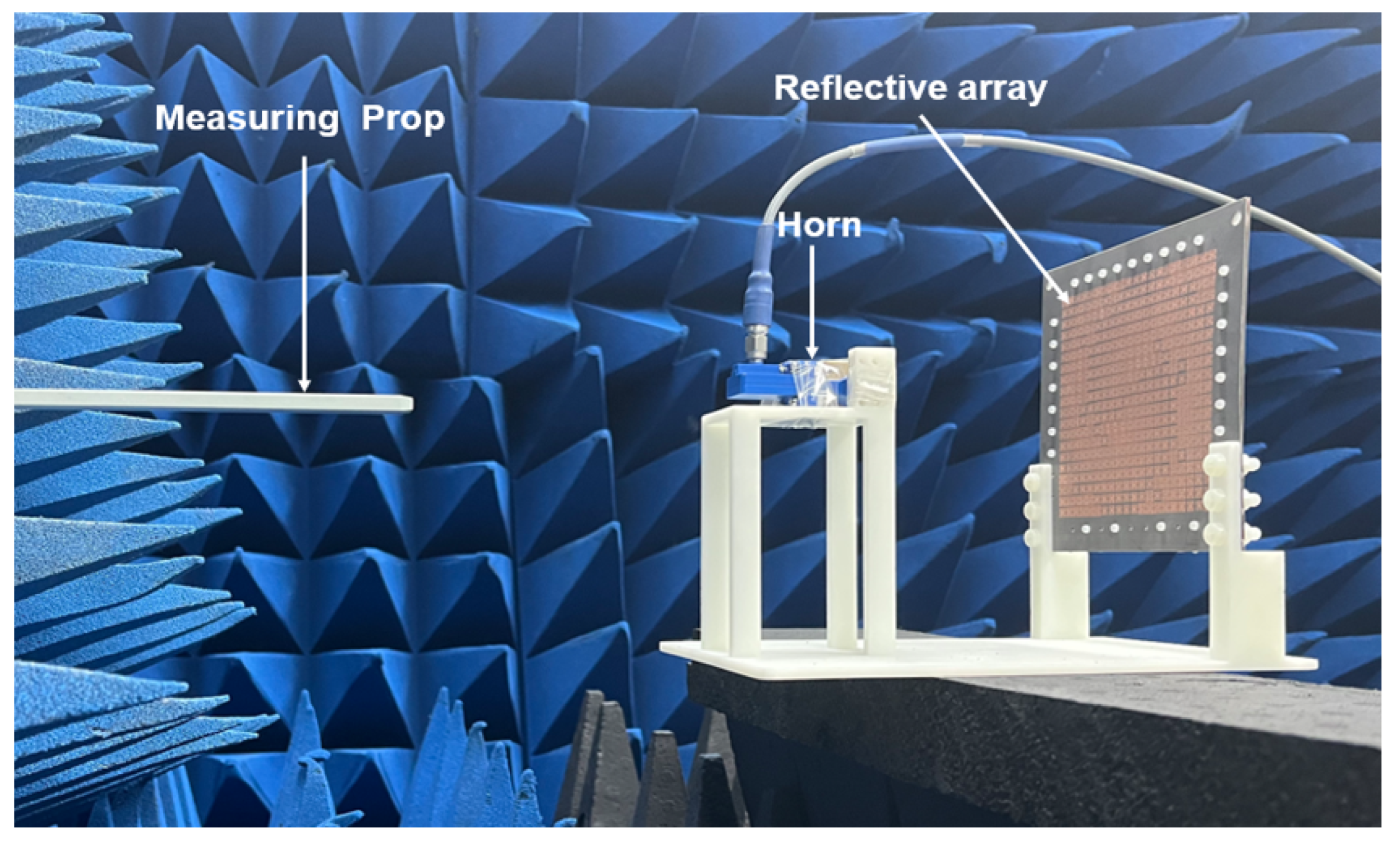
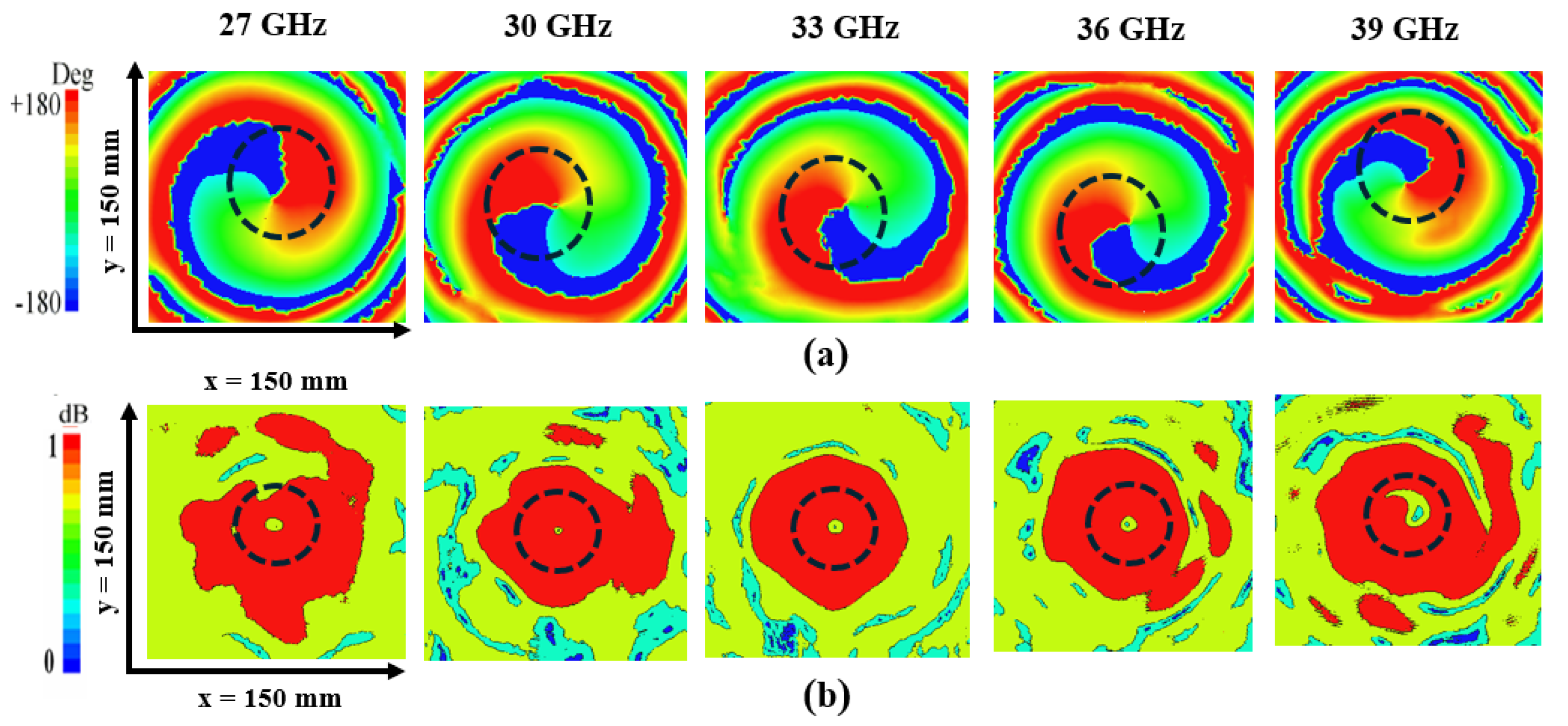

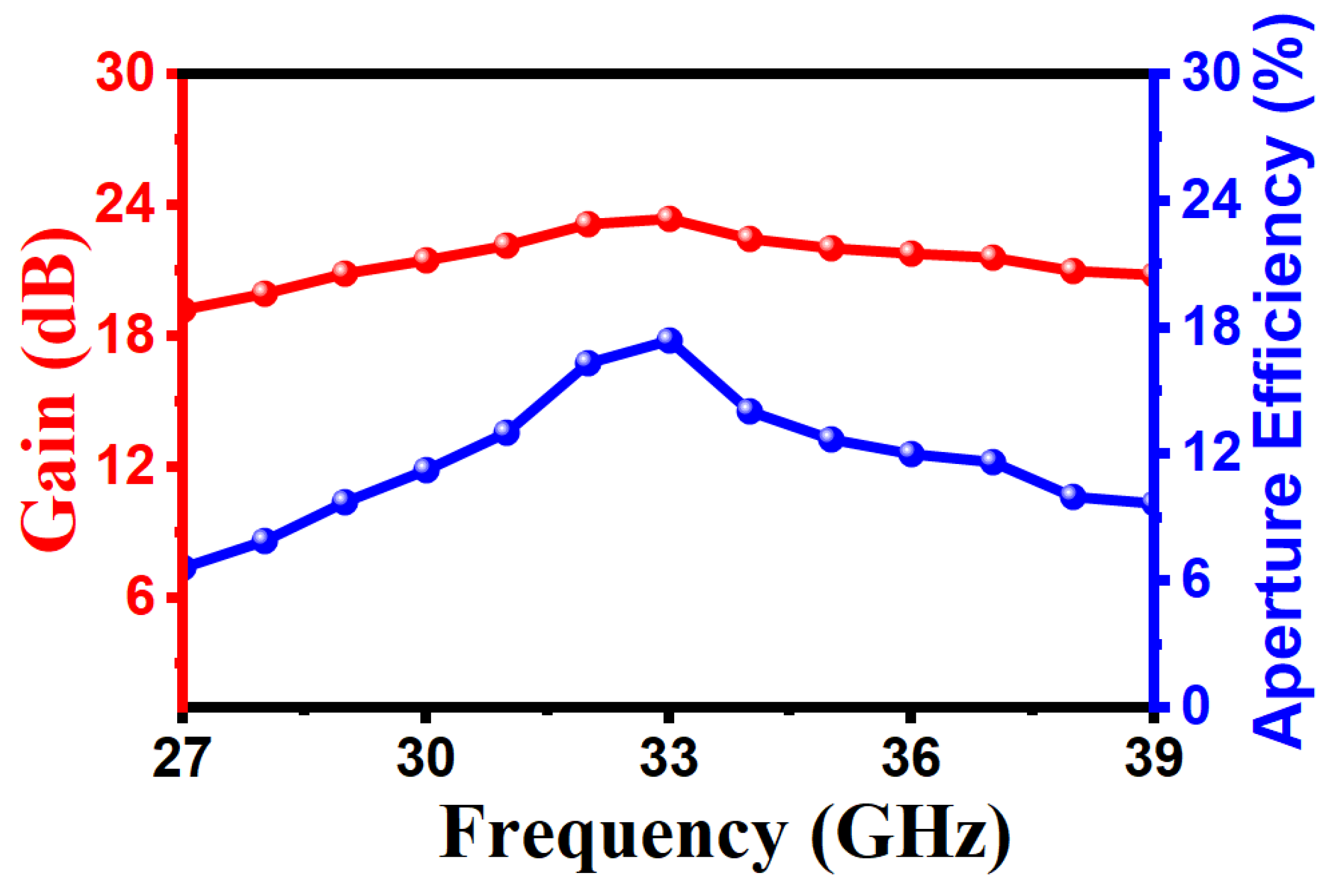
| Ref. | Frequency | Antenna Type | Element Phase | Profile | Mode | Mode Purity | OAM BW | Gain dBi | Aperture Efficiency |
|---|---|---|---|---|---|---|---|---|---|
| [15] | 10 GHz | Reflectarray | 400° | 0.13 | 1 | N/A | 20% | 19.9 | 7.2% |
| [18] | 5.75 GHz | Reflectarray | 750° | 0.12 | 1 | 50% | N/A | N/A | N/A |
| [20] | 5.8 GHz | Reflectarray | 377° | 0.11 | 1 | N/A | N/A | 15.4 | 22.6% |
| [22] | 15 GHz | Reflectarray | 360° | 0.18 | 1 | N/A | 40% | 18.42 | N/A |
| [26] | 10 GHz | Reflectarray | 360° | 0.10 | 1 | N/A | 40% | 20 | 14.35% |
| [27] | 30 GHz | Reflectarray | 360° | 0.5 | 1 | 62.6% | 21.7% | 20.5 | N/A |
| This Work | 30 GHz | Reflectarray | 440° | 0.10 | 1 | 78% | 40% | 23.39 | 17.78% |
Disclaimer/Publisher’s Note: The statements, opinions and data contained in all publications are solely those of the individual author(s) and contributor(s) and not of MDPI and/or the editor(s). MDPI and/or the editor(s) disclaim responsibility for any injury to people or property resulting from any ideas, methods, instructions or products referred to in the content. |
© 2025 by the authors. Licensee MDPI, Basel, Switzerland. This article is an open access article distributed under the terms and conditions of the Creative Commons Attribution (CC BY) license (https://creativecommons.org/licenses/by/4.0/).
Share and Cite
Khan, A.; Zhang, J.; Ishfaq, M.; Ahmad, I.; Khan, S.; Soothar, K.K. Compact Reflective Metasurface: Production of Broadband Vortex Beams in Millimeter Waves. Photonics 2025, 12, 305. https://doi.org/10.3390/photonics12040305
Khan A, Zhang J, Ishfaq M, Ahmad I, Khan S, Soothar KK. Compact Reflective Metasurface: Production of Broadband Vortex Beams in Millimeter Waves. Photonics. 2025; 12(4):305. https://doi.org/10.3390/photonics12040305
Chicago/Turabian StyleKhan, Asad, Jinling Zhang, Muhammad Ishfaq, Ibrar Ahmad, Shahbaz Khan, and Kamlesh Kumar Soothar. 2025. "Compact Reflective Metasurface: Production of Broadband Vortex Beams in Millimeter Waves" Photonics 12, no. 4: 305. https://doi.org/10.3390/photonics12040305
APA StyleKhan, A., Zhang, J., Ishfaq, M., Ahmad, I., Khan, S., & Soothar, K. K. (2025). Compact Reflective Metasurface: Production of Broadband Vortex Beams in Millimeter Waves. Photonics, 12(4), 305. https://doi.org/10.3390/photonics12040305






